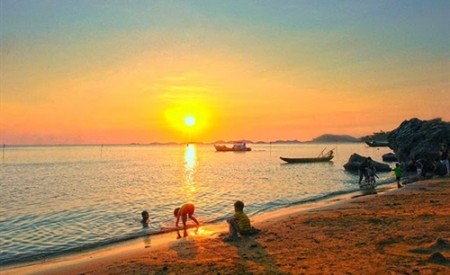Bung Binh Thien: Monsoon Beauty

Literally meaning “lake (Bung), “serene and peaceful” (Binh) and “sky” (Thien), Bung Binh Thien is a place of both natural beauty and historical richness that makes it a favourite tourist destination especially during the monsoon season (July to October) when the place is at its most divine.
Bung Binh Thien’s origin can be traced back to the 18th century when a general from the Tay Son dynasty selected the place to store food and train their soldiers. During that time, the terrain was still mostly dry, so the high-ranking official held a ritual asking the gods for rain and water. Local legend has it that after the ceremony, the general thrust his sword into the ground wherein fresh water sprung forth which eventually became the lake that it is today.
Bung Binh Thien is composed of two areas, a big one which is 193 hectares, and a smaller one which is only 10 hectares. The lake has an average depth of five metres which is formed from two small lakes from the Mekong River in Cambodia running to the Tien and Hau Rivers in Viet Nam in August. It is also connected to the Binh Di River which has a naturally “reddish seemingly opaque” colour, but changes into crystal clear blue as it meets the lake. The magnificent lake is beautifully accented with lotus, water lilies and water hyacinth. Different kinds of algae, which actually maintain the amazing clear blue colour of the lake, also reside at the bottom which help filter the water and prevent torrents.
Aside from the lake, there are other interesting things about Bung Binh Thien which makes it a must-visit. There are four ethnic groups living in the area each with its own unique culture and tradition: Kinh; Hoa; Khmer; and Cham. There is also a famous Islamic mosque called Mas Jid Khoy Ri Yah which is elaborately designed with one-of-a-kind South West Asian architecture like arched roofs and domes, pointed tops, upside down U-shaped doors, and big columns. The Cham ethnic group usually come here to worship.
The Cham ethnic group in particular is an interesting type of people because of their simple but charming culture. They live in a 100-year old village and are closely knit, as evidenced by their houses built close to each other. Children can be seen playing on the streets while the elderly go to the temple to pray. The women wear beautiful traditional costumes.
They also take pride in their food which is always fresh and delectable and uniquely served in lovely stilt houses. The Cham people are mostly farmers who toil in the fields in the dry season and double as cooks in the wet or water season. Cham specialty includes: snake-head mullet noodles; banh khot (little savory pancakes); banh xeo (sizzling crepes with Egyptian river hemp filling); shrimp sauce hot pot with climbing perch; Egyptian river hemp; water lilies with dipping sauce; henicorhynchus fish patties; and stewed henicorhynchus fish with green tamarind.
At night, guests are treated to a performance on the lake with a floating stage set on the water. Although there are no lights to highlight the show, the plants on the water more than make up as authentic back drop designs.
Life in Bung Binh Thien is generally laid back and in fact backward compared to many popular places today, but it is in fact this state of simplicity and natural beauty which draw many people from all over the world to discover and marvel at the place on their own.









